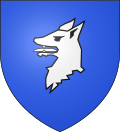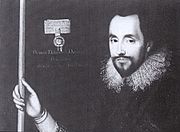Forests of Mara and Mondrem facts for kids
Quick facts for kids Forests of Mara and Mondrem |
|
|---|---|

The Forests of Mara and Mondrem (c. 1277–1536). Red dot: township within the forest; F: Frodsham; T: Tarporley; U: Utkinton; VR: Vale Royal Abbey; W: Weaverham
|
|
| Geography | |
| Location | Cheshire, England |
| Coordinates | 53°12′18″N 2°40′01″W / 53.205°N 2.667°W |
The Forests of Mara and Mondrem were two large, connected forests in Cheshire, England, during the Middle Ages. In the 11th century, they covered over 60 square miles (155 km²). They stretched from the River Mersey in the north almost to Nantwich in the south. To the west, they reached the River Gowy, and to the east, the River Weaver.
These forests were special "hunting forests" for the Earls of Chester, who were powerful Norman lords. The first earl, Hugh d'Avranches, created them around 1071. Before that, they might have been an Anglo-Saxon hunting area. Animals hunted here included wild boar and different types of deer like red, fallow, and roe deer.
After 1237, the right to control these forests passed to the King of England. The King's heir would then become the Earl of Chester. Kings like Edward I and James I enjoyed hunting in these forests. Over time, people were allowed to clear parts of the forest for farming, starting after 1215. By the mid-1300s, much of the Forest of Mondrem had been cleared. Deer hunting continued in the remaining parts until the 1600s. The forests were officially removed from "forest law" (special rules for royal forests) in 1812. Today, Delamere Forest is what's left of these old medieval forests, but very little of the original, ancient woodland remains.
Contents
Where Were the Forests?
In the 11th century, the Forests of Mara and Mondrem were huge. They stretched from the River Mersey in the north to just a few miles north of Nantwich in the south. From the River Gowy in the west, they reached the River Weaver in the east. The total area was more than 60 square miles (155 km²).
A document from between 1277 and 1536 lists 62 towns and villages inside these two forests. However, some of these places had special permission to be free from the strict "forest law."
We aren't completely sure where the exact border between Mara and Mondrem was. The Forest of Mara likely covered the northern part, including what is now Delamere Forest. The Forest of Mondrem was probably to the south, between Delamere and Nantwich. The boundary might have been an old road called "Peytevinisti." This road is thought to have run from Weaverham in the north, through Cuddington, to Tarporley in the south.
Forest History
Earls' Hunting Grounds

The Forests of Mara and Mondrem were one of three main hunting areas for the Earls of Chester. The other two were Macclesfield Forest and Wirral. Hugh d'Avranches, who loved hunting, created Mara and Mondrem soon after he became Earl of Chester in 1071. It's possible this area was already a hunting forest for the Anglo-Saxons before the Normans arrived.
When we say "forest" here, it doesn't just mean a place with lots of trees. It meant an area that followed special "forest law," not the usual common law. Most of the land within the forest was still privately owned. The forest boundaries were marked with "unmovable marks, meres, and boundaries." The whole area also seemed to be fenced off. Hunters used dogs to catch animals like wild boar and red, fallow, and roe deer.
The original woodland had many types of trees, mostly oak. It also included elm, lime, yew, chestnut, fir, larch, beech, ash, silver birch, hazel, willow, and alder. The forest also had open heathland, wetland, pastures, and even small farms and villages. However, farming was very limited inside the forest. Clearing new land for farming, called "assarting," was completely forbidden until 1215–16.
In the early Norman times, if you killed game illegally, you could be blinded or even executed. These harsh punishments slowly changed to very large fines. In 1215, the Magna Carta (a famous English document) reduced the maximum penalty for breaking forest law to fines or jail time. Ranulf de Blondeville, the 6th Earl, created a kinder set of laws for the Cheshire hunting forests in 1215–16.
This new law also allowed landowners to clear their land within the forest for farming without paying a fee. However, in Mara and Mondrem, people still had to pay a fine to clear land. It was 5 shillings per acre in Mondrem and 6 shillings 8 pence per acre in Mara. Later, you also needed a special permit to clear forest land, which cost even more money and was very unpopular. We don't have many records about land clearing in Mara and Mondrem during this time, but we know it happened in places like Frodsham, Weaverham, and Darnhall.
After the Earls
After the Earl of Chester title ended in 1237, the forest rights went to the King. The King's heir then became the Earl of Chester. Even though Edward I hunted in the forest, hunting became less important. The forests were then used more for getting timber and collecting money through taxes, fees, and fines.
In 1300, Edward I confirmed Ranulf de Blondeville's old law from 1215–16. But in the mid-1300s, Edward of Woodstock, known as the Black Prince, brought in stricter rules. This led to many complaints, which were written down in the Black Prince's Register in 1351. Farming on the eastern edge of the forest was also affected by outbreaks of the Black Death in 1349, 1361, and 1369. In the 1300s, areas like Old Pale and Eddisbury Hill were fenced off to keep deer inside.

The northern Forest of Mara still had many trees in the 1300s. It was also home to wild boar and even wolves. However, by this time, large parts of the southern Forest of Mondrem had been cleared. The remaining Mondrem woodland in the mid-1300s was mostly around Castle Northwich, Hartford, and Winnington in the north. There were also some woods in the southeast around Aston juxta Mondrum, Calveley, Cholmondeston, Church Minshull, Poole, and Wettenhall.
Vale Royal Abbey cleared a lot of land in Mondrem before it was closed down. The nearby medieval salt works of Nantwich and Middlewich also needed a lot of wood to fuel their salt pans, which might have caused more trees to be cut down.
Deer hunting continued in the 1600s. A large area called New Pale was fenced off to keep deer. James I visited Cheshire in August 1617 and hunted in the forest. He called it "this delightful place." But from the early 1700s, hunting changed. The Tarporley Hunt Club was started in 1762, and local wealthy people began hunting hares and later foxes instead of deer.
End of the Forest Status
In the late 1700s and early 1800s, much of the remaining forest land was fenced off. About 7,755 acres (3,138 ha) in the south of the Forest of Mara, which was then known as Delamere Forest, remained a hunting forest until the early 1800s.
In 1812, a law called an Enclosure Act was passed. This law "disafforested" the remaining forest. This meant it was no longer under special "forest law" and became ordinary land again. Ownership of this land was split, with half going to the Crown (the King) and half to the large landowners nearby. Today, very little of the original, ancient woodland is left. Most of it is found along the banks of the River Weaver and in steep cloughs (small valleys) leading to the river. There are also small patches of old, natural woodland in other places, like Cocked Hat Covert near Little Budworth, and Dorfold Park near Acton.
How the Forests Were Managed
Each of Cheshire's hunting forests had a "master-forester" who managed it for the Earl. For Mara and Mondrem, this job was passed down through families. Ranulf le Meschin, the 3rd Earl, gave this position to Ranulf or Ralph de Kingsley in 1123. Later, it passed to the Launcelyn family and then to the Done family from Utkinton and Tarporley. Sixteen members of the Done family held this job for almost 400 years! In 1662, the master-forestership went to the Crewe family, and then to the Ardernes, who held it until the forest was disafforested in 1812.
The master-forester's job was symbolized by a black horn. This horn was given to the Kingsleys in the 1100s. It's now called the "Delamere Horn" and is kept at the Grosvenor Museum. The master-foresters reported to the Chester "justiciar," who was in charge of all "forest law" across Cheshire's three forests.
Richard Done, a master-forester in the 1300s, wrote down all the special rights that came with the job. These included:
- The right shoulder of all deer killed during hunting.
- Trees that fell down or were cut down in the Earl's own woods.
- Swarms of bees, sparrowhawks, merlins, and hobbies found anywhere in the forest.
- The right of "pannage," which meant feeding pigs in the forest.
He also claimed halfpence for every cow and goat found wandering in the forest between Michaelmas (September 29) and Martinmas (November 11). He also received payments for pigs grazing between Martinmas and Christmas. Plus, he got to pick the best items from property taken from poachers (people who hunted illegally). The master-forester had a special lodge, called the "Chamber of the Forest," where he sometimes stayed. It was built in Peckforton in 1351 and later moved to Eddisbury Hill.
A large team helped the Mara and Mondrem master-forester. In the mid-1300s, this team included eight "underforesters" and two "garçons" who managed specific areas of the forest. They took on many of the roles that county sergeants (officers) had outside the forest. Also, "agisters" collected money for grazing animals, "verderers" attended the special forest courts, and "regarders" (inspectors), huntsmen, and kennelmen were also employed.

